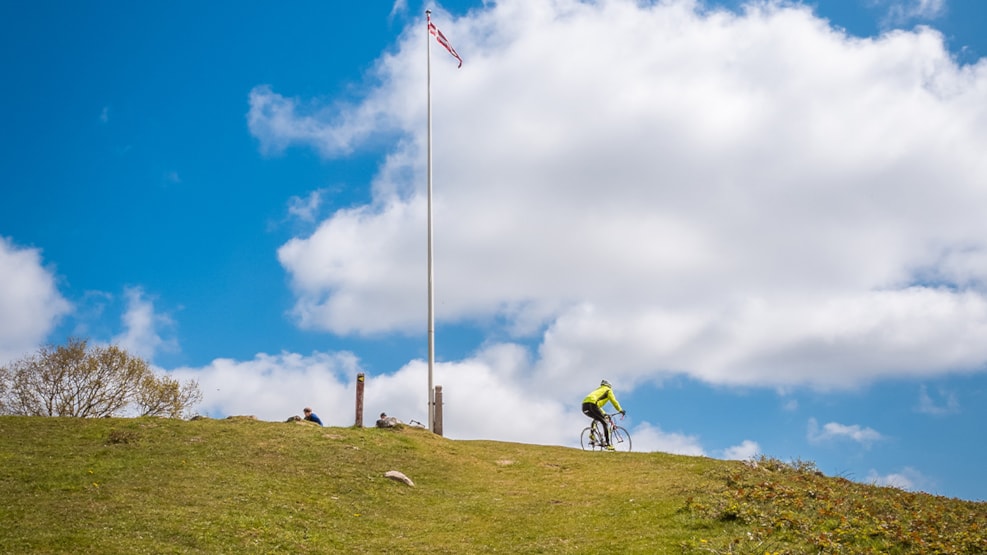
Tour suggestion: The Vissenbjerg area
Adventures for the whole family.
Description of Vissenbjerg Area
Start and end at Vissenbjerg Storkro.
Open the route on på Google Maps here: Vissenbjerg area.
Vissenbjerg Storkro
Turn right onto Søndersøvej and continue straight ahead. You will then reach the parking area for Terrariet Reptile Zoo and Vissenbjerg Bakker on your right.
Museum of the Koelbjerg Man & Ica Age
Discover how the Ice Age shaped the landscape and see the skeleton of the Koelbjerg Man, who lived 10,500 years ago.
Terrariet Reptile Zoo
Here, you’ll find one of Scandinavia’s largest collections of exotic animals, including snakes, lizards, komodo dragons, turtles, frogs, scorpions, and spiders. The terrarium offers exciting exhibits that provide a unique insight into the lives, behaviors, and habitats of animals from around the world.
Vissenbjerg Bakker (hills)
Embark on a hill tour of Funen. Here, at the top of Funen, glaciers have left behind a vast area of majestic hills, steep slopes, and deep valleys. At “Udsigten” (The view), you’ll reach 129 meters above sea level. From here, you can enjoy a fantastic view of Brændholt Bjerg and Frøbjerg Bavnehøj.
Frøbjerg Bavnehøj - Funen's highets point
Continue to Frøbjerg and climb Frøbjerg Bavnehøj, Funen’s highest point at 131 meters. From the top of the Bavnehøj, you’ll be rewarded with an incredible view of Funen. The landscape was shaped during the Ice Age. In ancient times, bonfires (bavn) were lit on the hills throughout the country to communicate with one another. Bavnehøj is part of a characteristic dead-ice landscape. The hills are flat at the top with very steep sides and marked meltwater valleys. The 12-hectare area around Frøbjerg Bavnehøj is owned by the Danish Nature Agency and was protected in 1947. The area consists of two hills: Bavnehøj itself at 131 meters and the smaller hill at 122 meters.
At Frøbjerg, there is also a memorial grove for the victims of the German occupation during World War II, as well as several other memorials. In the old icehouse at the foot of Frøbjerg Bavnehøj, there is a small summer exhibition telling the history of Frøbjerg Bavnehøj. Frøbjerg is named after the fertility god Frø or Frej. In ancient times, Frøbjerg was a sacred site, where springtime offerings were held. At the small hill lies the festival grounds, where the Frøbjerg Festival has held outdoor theater performances since 1986. Every year, the festival attracts nearly 25,000 people into the nature. Until 1910, the hills were grassy and treeless, used for grazing both sheep and cattle. In 1911-1912, the Bavnehøj Society planted many of the trees that are present today, but since then, many more trees and bushes have been planted and pruned to preserve the unique view. Today, the hills are grazed by sheep, which help keep the trees and bushes under control.
Skoda Museum & The Flax Weaving Museum in Krengerup
Continue to Krengerup Gods, where you’ll find two fascinating museums. At Škoda Museum Denmark, you can view an impressive collection of Škoda models, showcasing the brand’s development from its early years to the present. Next door, you’ll find The Flax Weaving Museum (Hørvævsmuseet), where you can dive into Denmark’s textile history. The museum offers a fascinating look into the importance of flax production for Funen and the rest of Denmark. See the old looms in action, experience the craftsmanship up close, and learn about the entire process from flax plant to finished textile.
Lilleskov Teglværk (brickworks)
Continue your journey towards Tommerup Stationsby. Take a short detour off Lilleskovvej to see Lilleskov Teglværk. The museum was founded in 1985 to preserve and operate the brickworks. It is open on only a few days throughout the year, but with prior arrangement, you can visit.
Follow the route back to Vissenbjerg Storkro.